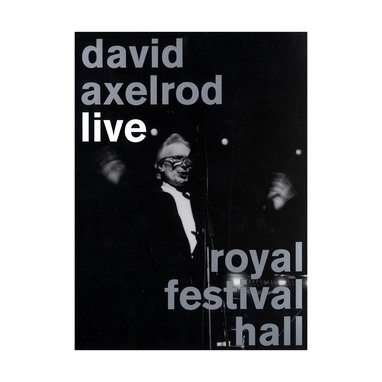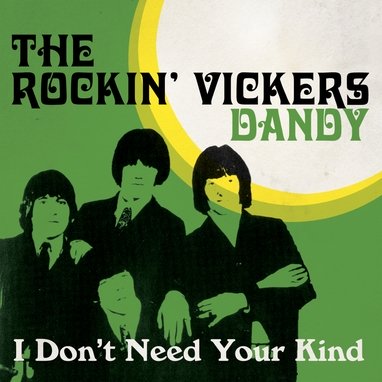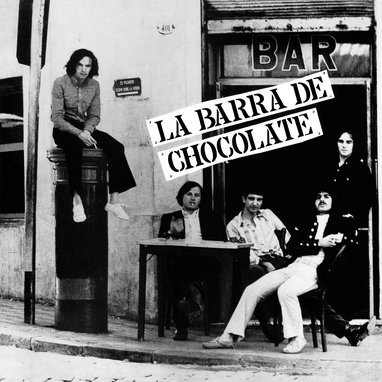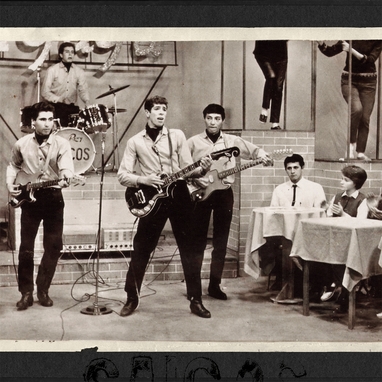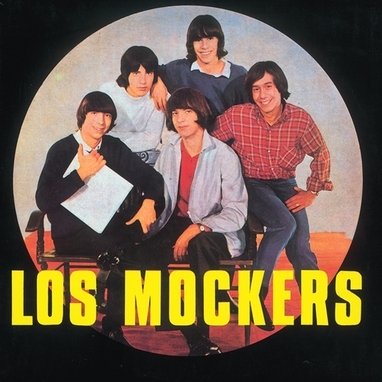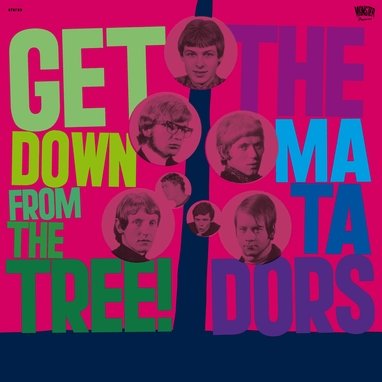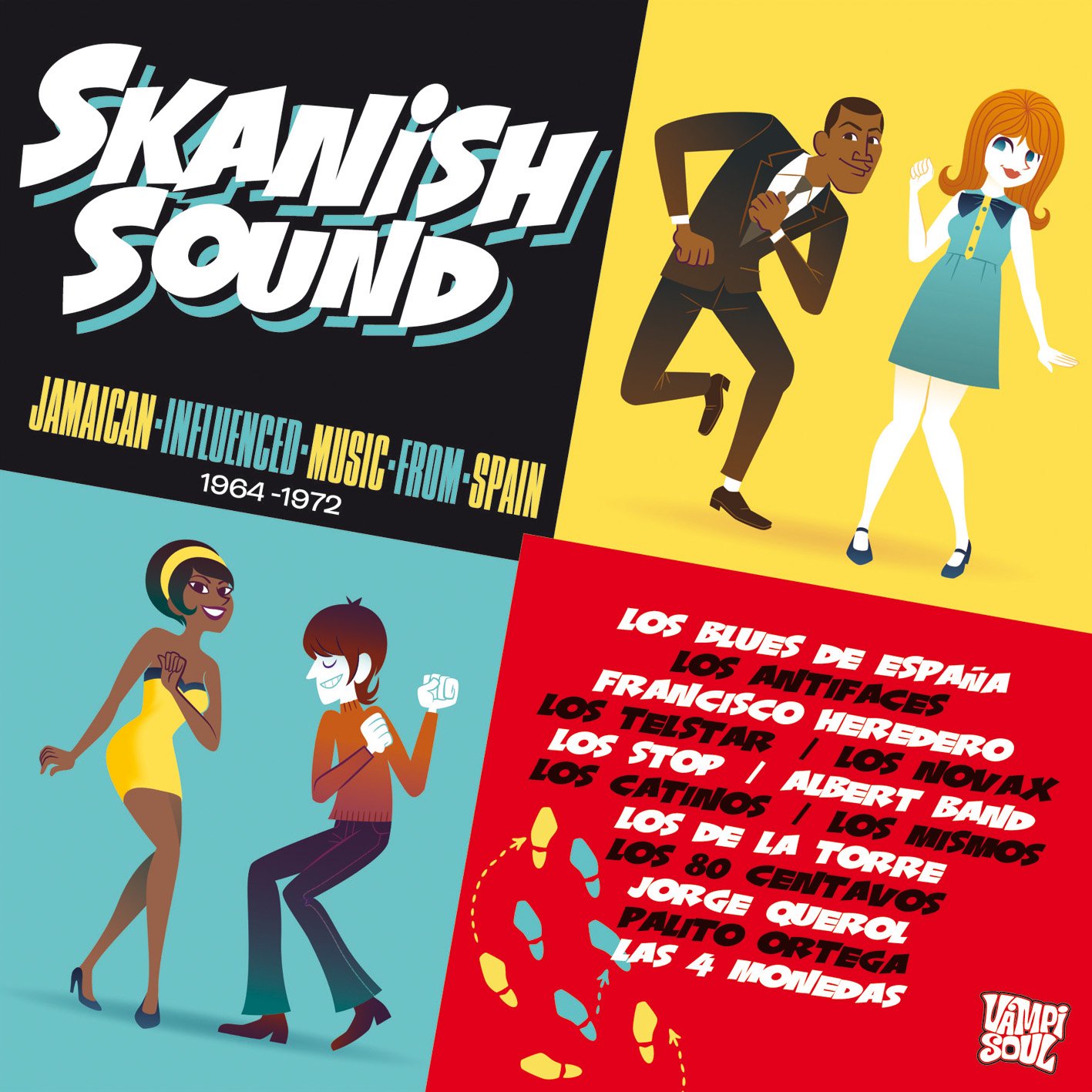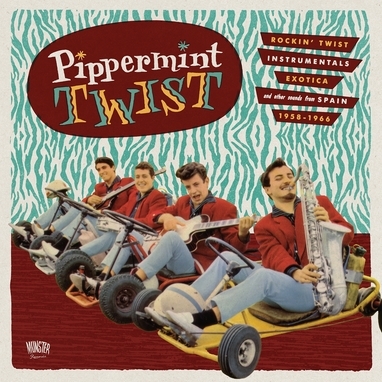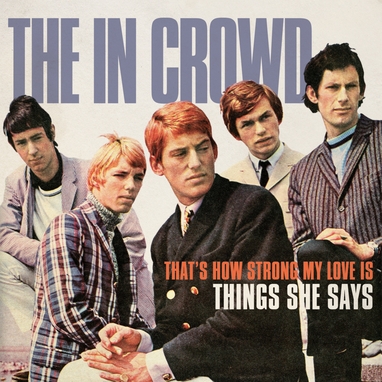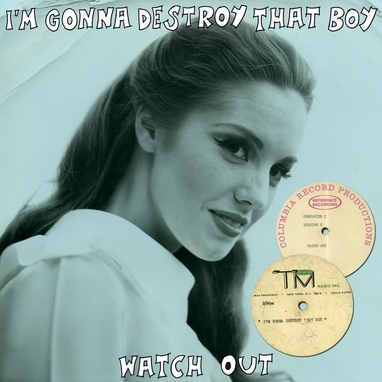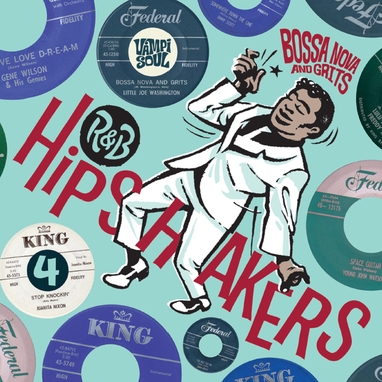Pau Riba
Dioptria
Munster
Pau Riba
Dioptria
Special 50th anniversary reissue of Pau Riba’s first album in its intended double LP format in gatefold sleeve with 12-page booklet featuring lyrics in Catalan and Spanish.. Released as two separate records in 1969 and 1970, Riba was barely 20-21 years old when he created this expansive and outstanding work of psychedelic folk-rock accompanied by the band Om and members of Música Dispersa. The beginning of the unique career of this essential figure of Catalan music and counterculture. Presented in facsimile artwork and pressed on 180g vinyl.
Dioptria by Pau Riba 1. sack full of songs
in may 1968 – when my first book, titled Cançons i poems, was published – i wasn't 20 years old yet but already carried a sack full of my own songs… and had a first EP in the market. i hesitate to talk about precociousness, but the truth is that my first creative outburst took place right in the middle of teenagehood and that, at the time, songs were pouring out of my ears. that's why when, after a second ep, my record label boss suggested releasing a debut LP, i told him it had to be double. since we were on good terms, as i was working for him as a graphic designer making covers and other things, he agreed, and i started demoing my first album 2. the musicians the second step was choosing which musicians i would work with, as none of the line-ups of the first two eps were diverse enough. who to choose? by chance i heard an EP by Maria del Mar Bonet accompanied by OM and my head flipped: i realized that catalan cançó could be treated in a modern and unconventional way. i was missing just one thing: rock, or, as i've always called it, roc without the 'k': that rhythmic toughness that could be applied to any musical genre. i went to see OM and i explained it to them (to me, roc was the axis of young people's revolution, youth's own and unique language). so that's the way it had to be done, in order to be current and go through frontiers. there was no objection 3. the recording the decision was right: Toti – who had just arrived from London with the first distortion pedal i ever saw and played –, Jordi and Romà gave their all and contributed with interest, enthusiasm and brilliance, while Doro and Jose adapted to the indications given by the other three. with regards to the recording, it was a party: friends sitting down with respect both in the room and in the booth, where Rafael Poch, the technician, worked his magic… considering he only had four tracks to work with, with a very young Xavier Batllés as assistant, maestro Casas Augé in the role of artistic director, and – to top it all – Mr Ortiz, the owner: a loud retired bullfighter who used to come round to encourage us and talk about his then current wine business 4. the cover with regards to the title of the album, my teenage arrogance made me pick an ophthalmology term which affects all short-sighted people – such as me – in order to claim: you're all blind, you don't know what's going on. and as for the cover, i can't remember (and i've really tried!) how i got hold of that image of a naked baby, abandoned in the middle of nature, the work of the german romantic painter Philipp Otto Runge, which enabled me to show the defenceless purity and innocence against the monsters of a menacing world. with time i learned that it's from a painting called Der Morgen (The Dawn) which, in his deathbed, Runge asked his brother to destroy. instead, the latter cut it into nine pieces and sold them separately 5. the monsters that explains why this fragment was around, this ninth part of a canvas where just the baby – not Jesus – appears naked at the feet of the divine Dawn, which i used for the front cover, where the letters have the colours of the republican flag, and also for the back cover, where the child is suffocated by a collage that i made using medical magazines: a placenta full of human abominations, surrounded by monsters sketched by Ricard Pié which, considering them too naive, as soon as i could i asked Nazario to draw again and he turned them into ferocious viperish penises. i wanted a disgusting illustration about all that self-righteous minds don't want to see. dedicated to them, the short-sighted-dioptric 6. the colours another – failed – part of the sleeve design of the double album is that the inner pages where the lyrics are printed (in catalan and translated into spanish) are three double pages in a kind of wrapping paper typical at the time, in three different widths and colours: red, yellow and purple; that is, the republican flag again… yes: although we were in the middle of Franco's dictatorship, the state of autonomies wasn't yet a concept and the republic was something remote, prior to the civil war. however, when the sleeve came out of the printers the order of the pages had been altered and they didn't form the flag anymore. i've never known whether it was a simple slip or a malicious mistake by someone 7. the hippy utopia the record was a success, as i expected: with such complete freedom, it turned out great… but expensive. so the label's boss decided that, although the sleeve was double, for now there would only be one record: the second one depended on how things went with the first one (he claimed that the fact that there was only one record to begin with was a good thing, as it would encourage people to buy the other one as soon as it came out). but it wasn't quite like that: on one hand, because between the two records, in the summer of 1969, i arrived in Formentera, had my first experience with LSD and adopted the precepts of the hippy utopia; on the other hand, i fell in love with Música Dispersa, who made minimal and highly original music, and, forgetting about OM, i decided to make the second album with them 8. música dispersa José Manuel Cachas Brabo was outstanding; Jaume Sisa, a genius; Albert Batiste, an all-terrain musician; and Lourdes Selene Parés, a woman with a brilliant instinct for music. When i shared my idea with them, Cachas refused straight away and Selene agreed with him. therefore it was down to Sisa and Albert Batiste; but the truth is that, when it came to it, the record was made by Albert and me, side by side. Sisa just contributed some clapping here and there and some backing vocals. nevertheless, i achieved what i wanted, a lighter orchestration and a more acoustic and hippyish sound, without diminishing the quality 9. the divine Dawn there's also the unusual fact that the label's boss, in a ridiculous and exaggerated patriotic outburst, claiming to voice all catalans (democracy was unheard of at the time) and adopting the tone of a benevolent father who must correct the mistakes of his crazy son, decided to add a text after mine – yes, yes, inside the record, inside my work! – refuting all my statements. completely ignoring – or maybe not realizing – that it's a metaphorical text, a piece of poetic prose… and even prophetic, premonitory. because, in fact, the divine Dawn was already in the record without really being there, and it was there to announce the dawn of a new era, both for me and in the universal astrological sense that affects us all, or in the digital technological sense where virtuality has ended up bending space… and reality
Productos relacionados
Special 50th anniversary reissue of Pau Riba’s first album in its intended double LP format in gatefold sleeve with 12-page booklet featuring lyrics in Catalan and Spanish.. Released as two separate records in 1969 and 1970, Riba was barely 20-21 years old when he created this expansive and outstanding work of psychedelic folk-rock accompanied by the band Om and members of Música Dispersa. The beginning of the unique career of this essential figure of Catalan music and counterculture. Presented in facsimile artwork and pressed on 180g vinyl.
Dioptria by Pau Riba 1. sack full of songs
in may 1968 – when my first book, titled Cançons i poems, was published – i wasn't 20 years old yet but already carried a sack full of my own songs… and had a first EP in the market. i hesitate to talk about precociousness, but the truth is that my first creative outburst took place right in the middle of teenagehood and that, at the time, songs were pouring out of my ears. that's why when, after a second ep, my record label boss suggested releasing a debut LP, i told him it had to be double. since we were on good terms, as i was working for him as a graphic designer making covers and other things, he agreed, and i started demoing my first album 2. the musicians the second step was choosing which musicians i would work with, as none of the line-ups of the first two eps were diverse enough. who to choose? by chance i heard an EP by Maria del Mar Bonet accompanied by OM and my head flipped: i realized that catalan cançó could be treated in a modern and unconventional way. i was missing just one thing: rock, or, as i've always called it, roc without the 'k': that rhythmic toughness that could be applied to any musical genre. i went to see OM and i explained it to them (to me, roc was the axis of young people's revolution, youth's own and unique language). so that's the way it had to be done, in order to be current and go through frontiers. there was no objection 3. the recording the decision was right: Toti – who had just arrived from London with the first distortion pedal i ever saw and played –, Jordi and Romà gave their all and contributed with interest, enthusiasm and brilliance, while Doro and Jose adapted to the indications given by the other three. with regards to the recording, it was a party: friends sitting down with respect both in the room and in the booth, where Rafael Poch, the technician, worked his magic… considering he only had four tracks to work with, with a very young Xavier Batllés as assistant, maestro Casas Augé in the role of artistic director, and – to top it all – Mr Ortiz, the owner: a loud retired bullfighter who used to come round to encourage us and talk about his then current wine business 4. the cover with regards to the title of the album, my teenage arrogance made me pick an ophthalmology term which affects all short-sighted people – such as me – in order to claim: you're all blind, you don't know what's going on. and as for the cover, i can't remember (and i've really tried!) how i got hold of that image of a naked baby, abandoned in the middle of nature, the work of the german romantic painter Philipp Otto Runge, which enabled me to show the defenceless purity and innocence against the monsters of a menacing world. with time i learned that it's from a painting called Der Morgen (The Dawn) which, in his deathbed, Runge asked his brother to destroy. instead, the latter cut it into nine pieces and sold them separately 5. the monsters that explains why this fragment was around, this ninth part of a canvas where just the baby – not Jesus – appears naked at the feet of the divine Dawn, which i used for the front cover, where the letters have the colours of the republican flag, and also for the back cover, where the child is suffocated by a collage that i made using medical magazines: a placenta full of human abominations, surrounded by monsters sketched by Ricard Pié which, considering them too naive, as soon as i could i asked Nazario to draw again and he turned them into ferocious viperish penises. i wanted a disgusting illustration about all that self-righteous minds don't want to see. dedicated to them, the short-sighted-dioptric 6. the colours another – failed – part of the sleeve design of the double album is that the inner pages where the lyrics are printed (in catalan and translated into spanish) are three double pages in a kind of wrapping paper typical at the time, in three different widths and colours: red, yellow and purple; that is, the republican flag again… yes: although we were in the middle of Franco's dictatorship, the state of autonomies wasn't yet a concept and the republic was something remote, prior to the civil war. however, when the sleeve came out of the printers the order of the pages had been altered and they didn't form the flag anymore. i've never known whether it was a simple slip or a malicious mistake by someone 7. the hippy utopia the record was a success, as i expected: with such complete freedom, it turned out great… but expensive. so the label's boss decided that, although the sleeve was double, for now there would only be one record: the second one depended on how things went with the first one (he claimed that the fact that there was only one record to begin with was a good thing, as it would encourage people to buy the other one as soon as it came out). but it wasn't quite like that: on one hand, because between the two records, in the summer of 1969, i arrived in Formentera, had my first experience with LSD and adopted the precepts of the hippy utopia; on the other hand, i fell in love with Música Dispersa, who made minimal and highly original music, and, forgetting about OM, i decided to make the second album with them 8. música dispersa José Manuel Cachas Brabo was outstanding; Jaume Sisa, a genius; Albert Batiste, an all-terrain musician; and Lourdes Selene Parés, a woman with a brilliant instinct for music. When i shared my idea with them, Cachas refused straight away and Selene agreed with him. therefore it was down to Sisa and Albert Batiste; but the truth is that, when it came to it, the record was made by Albert and me, side by side. Sisa just contributed some clapping here and there and some backing vocals. nevertheless, i achieved what i wanted, a lighter orchestration and a more acoustic and hippyish sound, without diminishing the quality 9. the divine Dawn there's also the unusual fact that the label's boss, in a ridiculous and exaggerated patriotic outburst, claiming to voice all catalans (democracy was unheard of at the time) and adopting the tone of a benevolent father who must correct the mistakes of his crazy son, decided to add a text after mine – yes, yes, inside the record, inside my work! – refuting all my statements. completely ignoring – or maybe not realizing – that it's a metaphorical text, a piece of poetic prose… and even prophetic, premonitory. because, in fact, the divine Dawn was already in the record without really being there, and it was there to announce the dawn of a new era, both for me and in the universal astrological sense that affects us all, or in the digital technological sense where virtuality has ended up bending space… and reality
Productos relacionados
Dioptria
Special 50th anniversary reissue of Pau Riba’s first album in its intended double LP format in gatefold sleeve with 12-page booklet featuring lyrics in Catalan and Spanish.. Released as two separate records in 1969 and 1970, Riba was barely 20-21 years old when he created this expansive and outstanding work of psychedelic folk-rock accompanied by the band Om and members of Música Dispersa. The beginning of the unique career of this essential figure of Catalan music and counterculture. Presented in facsimile artwork and pressed on 180g vinyl.
Dioptria by Pau Riba 1. sack full of songs
in may 1968 – when my first book, titled Cançons i poems, was published – i wasn't 20 years old yet but already carried a sack full of my own songs… and had a first EP in the market. i hesitate to talk about precociousness, but the truth is that my first creative outburst took place right in the middle of teenagehood and that, at the time, songs were pouring out of my ears. that's why when, after a second ep, my record label boss suggested releasing a debut LP, i told him it had to be double. since we were on good terms, as i was working for him as a graphic designer making covers and other things, he agreed, and i started demoing my first album 2. the musicians the second step was choosing which musicians i would work with, as none of the line-ups of the first two eps were diverse enough. who to choose? by chance i heard an EP by Maria del Mar Bonet accompanied by OM and my head flipped: i realized that catalan cançó could be treated in a modern and unconventional way. i was missing just one thing: rock, or, as i've always called it, roc without the 'k': that rhythmic toughness that could be applied to any musical genre. i went to see OM and i explained it to them (to me, roc was the axis of young people's revolution, youth's own and unique language). so that's the way it had to be done, in order to be current and go through frontiers. there was no objection 3. the recording the decision was right: Toti – who had just arrived from London with the first distortion pedal i ever saw and played –, Jordi and Romà gave their all and contributed with interest, enthusiasm and brilliance, while Doro and Jose adapted to the indications given by the other three. with regards to the recording, it was a party: friends sitting down with respect both in the room and in the booth, where Rafael Poch, the technician, worked his magic… considering he only had four tracks to work with, with a very young Xavier Batllés as assistant, maestro Casas Augé in the role of artistic director, and – to top it all – Mr Ortiz, the owner: a loud retired bullfighter who used to come round to encourage us and talk about his then current wine business 4. the cover with regards to the title of the album, my teenage arrogance made me pick an ophthalmology term which affects all short-sighted people – such as me – in order to claim: you're all blind, you don't know what's going on. and as for the cover, i can't remember (and i've really tried!) how i got hold of that image of a naked baby, abandoned in the middle of nature, the work of the german romantic painter Philipp Otto Runge, which enabled me to show the defenceless purity and innocence against the monsters of a menacing world. with time i learned that it's from a painting called Der Morgen (The Dawn) which, in his deathbed, Runge asked his brother to destroy. instead, the latter cut it into nine pieces and sold them separately 5. the monsters that explains why this fragment was around, this ninth part of a canvas where just the baby – not Jesus – appears naked at the feet of the divine Dawn, which i used for the front cover, where the letters have the colours of the republican flag, and also for the back cover, where the child is suffocated by a collage that i made using medical magazines: a placenta full of human abominations, surrounded by monsters sketched by Ricard Pié which, considering them too naive, as soon as i could i asked Nazario to draw again and he turned them into ferocious viperish penises. i wanted a disgusting illustration about all that self-righteous minds don't want to see. dedicated to them, the short-sighted-dioptric 6. the colours another – failed – part of the sleeve design of the double album is that the inner pages where the lyrics are printed (in catalan and translated into spanish) are three double pages in a kind of wrapping paper typical at the time, in three different widths and colours: red, yellow and purple; that is, the republican flag again… yes: although we were in the middle of Franco's dictatorship, the state of autonomies wasn't yet a concept and the republic was something remote, prior to the civil war. however, when the sleeve came out of the printers the order of the pages had been altered and they didn't form the flag anymore. i've never known whether it was a simple slip or a malicious mistake by someone 7. the hippy utopia the record was a success, as i expected: with such complete freedom, it turned out great… but expensive. so the label's boss decided that, although the sleeve was double, for now there would only be one record: the second one depended on how things went with the first one (he claimed that the fact that there was only one record to begin with was a good thing, as it would encourage people to buy the other one as soon as it came out). but it wasn't quite like that: on one hand, because between the two records, in the summer of 1969, i arrived in Formentera, had my first experience with LSD and adopted the precepts of the hippy utopia; on the other hand, i fell in love with Música Dispersa, who made minimal and highly original music, and, forgetting about OM, i decided to make the second album with them 8. música dispersa José Manuel Cachas Brabo was outstanding; Jaume Sisa, a genius; Albert Batiste, an all-terrain musician; and Lourdes Selene Parés, a woman with a brilliant instinct for music. When i shared my idea with them, Cachas refused straight away and Selene agreed with him. therefore it was down to Sisa and Albert Batiste; but the truth is that, when it came to it, the record was made by Albert and me, side by side. Sisa just contributed some clapping here and there and some backing vocals. nevertheless, i achieved what i wanted, a lighter orchestration and a more acoustic and hippyish sound, without diminishing the quality 9. the divine Dawn there's also the unusual fact that the label's boss, in a ridiculous and exaggerated patriotic outburst, claiming to voice all catalans (democracy was unheard of at the time) and adopting the tone of a benevolent father who must correct the mistakes of his crazy son, decided to add a text after mine – yes, yes, inside the record, inside my work! – refuting all my statements. completely ignoring – or maybe not realizing – that it's a metaphorical text, a piece of poetic prose… and even prophetic, premonitory. because, in fact, the divine Dawn was already in the record without really being there, and it was there to announce the dawn of a new era, both for me and in the universal astrological sense that affects us all, or in the digital technological sense where virtuality has ended up bending space… and reality
Special 50th anniversary reissue of Pau Riba’s first album in its intended double LP format in gatefold sleeve with 12-page booklet featuring lyrics in Catalan and Spanish.. Released as two separate records in 1969 and 1970, Riba was barely 20-21 years old when he created this expansive and outstanding work of psychedelic folk-rock accompanied by the band Om and members of Música Dispersa. The beginning of the unique career of this essential figure of Catalan music and counterculture. Presented in facsimile artwork and pressed on 180g vinyl.
Dioptria by Pau Riba 1. sack full of songs
in may 1968 – when my first book, titled Cançons i poems, was published – i wasn't 20 years old yet but already carried a sack full of my own songs… and had a first EP in the market. i hesitate to talk about precociousness, but the truth is that my first creative outburst took place right in the middle of teenagehood and that, at the time, songs were pouring out of my ears. that's why when, after a second ep, my record label boss suggested releasing a debut LP, i told him it had to be double. since we were on good terms, as i was working for him as a graphic designer making covers and other things, he agreed, and i started demoing my first album 2. the musicians the second step was choosing which musicians i would work with, as none of the line-ups of the first two eps were diverse enough. who to choose? by chance i heard an EP by Maria del Mar Bonet accompanied by OM and my head flipped: i realized that catalan cançó could be treated in a modern and unconventional way. i was missing just one thing: rock, or, as i've always called it, roc without the 'k': that rhythmic toughness that could be applied to any musical genre. i went to see OM and i explained it to them (to me, roc was the axis of young people's revolution, youth's own and unique language). so that's the way it had to be done, in order to be current and go through frontiers. there was no objection 3. the recording the decision was right: Toti – who had just arrived from London with the first distortion pedal i ever saw and played –, Jordi and Romà gave their all and contributed with interest, enthusiasm and brilliance, while Doro and Jose adapted to the indications given by the other three. with regards to the recording, it was a party: friends sitting down with respect both in the room and in the booth, where Rafael Poch, the technician, worked his magic… considering he only had four tracks to work with, with a very young Xavier Batllés as assistant, maestro Casas Augé in the role of artistic director, and – to top it all – Mr Ortiz, the owner: a loud retired bullfighter who used to come round to encourage us and talk about his then current wine business 4. the cover with regards to the title of the album, my teenage arrogance made me pick an ophthalmology term which affects all short-sighted people – such as me – in order to claim: you're all blind, you don't know what's going on. and as for the cover, i can't remember (and i've really tried!) how i got hold of that image of a naked baby, abandoned in the middle of nature, the work of the german romantic painter Philipp Otto Runge, which enabled me to show the defenceless purity and innocence against the monsters of a menacing world. with time i learned that it's from a painting called Der Morgen (The Dawn) which, in his deathbed, Runge asked his brother to destroy. instead, the latter cut it into nine pieces and sold them separately 5. the monsters that explains why this fragment was around, this ninth part of a canvas where just the baby – not Jesus – appears naked at the feet of the divine Dawn, which i used for the front cover, where the letters have the colours of the republican flag, and also for the back cover, where the child is suffocated by a collage that i made using medical magazines: a placenta full of human abominations, surrounded by monsters sketched by Ricard Pié which, considering them too naive, as soon as i could i asked Nazario to draw again and he turned them into ferocious viperish penises. i wanted a disgusting illustration about all that self-righteous minds don't want to see. dedicated to them, the short-sighted-dioptric 6. the colours another – failed – part of the sleeve design of the double album is that the inner pages where the lyrics are printed (in catalan and translated into spanish) are three double pages in a kind of wrapping paper typical at the time, in three different widths and colours: red, yellow and purple; that is, the republican flag again… yes: although we were in the middle of Franco's dictatorship, the state of autonomies wasn't yet a concept and the republic was something remote, prior to the civil war. however, when the sleeve came out of the printers the order of the pages had been altered and they didn't form the flag anymore. i've never known whether it was a simple slip or a malicious mistake by someone 7. the hippy utopia the record was a success, as i expected: with such complete freedom, it turned out great… but expensive. so the label's boss decided that, although the sleeve was double, for now there would only be one record: the second one depended on how things went with the first one (he claimed that the fact that there was only one record to begin with was a good thing, as it would encourage people to buy the other one as soon as it came out). but it wasn't quite like that: on one hand, because between the two records, in the summer of 1969, i arrived in Formentera, had my first experience with LSD and adopted the precepts of the hippy utopia; on the other hand, i fell in love with Música Dispersa, who made minimal and highly original music, and, forgetting about OM, i decided to make the second album with them 8. música dispersa José Manuel Cachas Brabo was outstanding; Jaume Sisa, a genius; Albert Batiste, an all-terrain musician; and Lourdes Selene Parés, a woman with a brilliant instinct for music. When i shared my idea with them, Cachas refused straight away and Selene agreed with him. therefore it was down to Sisa and Albert Batiste; but the truth is that, when it came to it, the record was made by Albert and me, side by side. Sisa just contributed some clapping here and there and some backing vocals. nevertheless, i achieved what i wanted, a lighter orchestration and a more acoustic and hippyish sound, without diminishing the quality 9. the divine Dawn there's also the unusual fact that the label's boss, in a ridiculous and exaggerated patriotic outburst, claiming to voice all catalans (democracy was unheard of at the time) and adopting the tone of a benevolent father who must correct the mistakes of his crazy son, decided to add a text after mine – yes, yes, inside the record, inside my work! – refuting all my statements. completely ignoring – or maybe not realizing – that it's a metaphorical text, a piece of poetic prose… and even prophetic, premonitory. because, in fact, the divine Dawn was already in the record without really being there, and it was there to announce the dawn of a new era, both for me and in the universal astrological sense that affects us all, or in the digital technological sense where virtuality has ended up bending space… and reality


